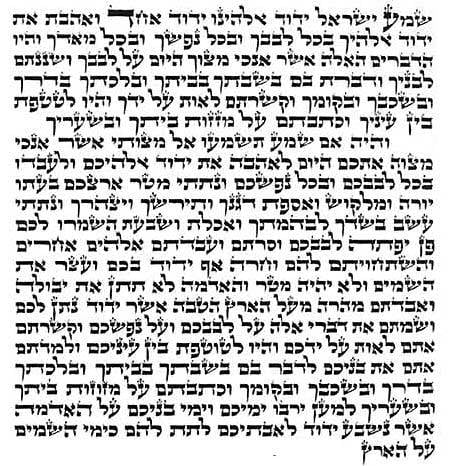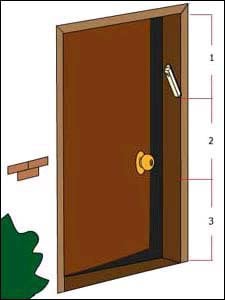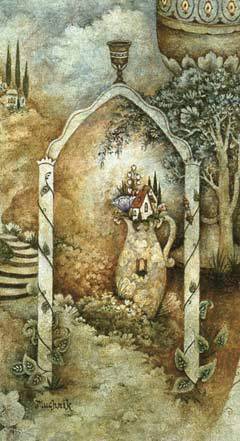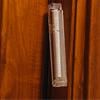The Ultimate Home Security Device:
As every homeowner knows, it's not those little gadgets with the flashing lights that protect your home. It's the police station. You just need to make sure those gadgets are connected.
A mezuzah on your doorpost works the same way — only that it's connected to a Higher Protection Agency. Much higher.
In fact, that's how every mitzvah works — tefillin, Shabbat candles, Torah study, acts of kindness. Think of them as dedicated connections putting you online with the Infinite Server of All Things.
Mezuzahs, however, have a special quality: They connect directly to the protection function. As the sages of the Talmud taught, put a mezuzah on your door and you're protected in your house and away. Now that's something no earthbound service offers.
That's why, in 1974, when terrorism began to rise, the Lubavitcher Rebbe, Rabbi Menachem Mendel Schneerson, declared a worldwide mezuzah blitz. Thanks to that campaign, mezuzahs are once again a standard feature on Jewish doorposts everywhere.
What is a Mezuzah?
A mezuzah is a scroll that is affixed to the doorposts of a Jewish home. It is made from parchment and inscribed with the words of the Shema Yisrael (Deuteronomy 6:4-9 and 11:13-21). These are the same words that a Jew recites every morning and evening. They contain the quintessential, primal statement of what it means to be a Jew: To permeate our entire day and everything we own with G‑d's oneness.
Here are the first five verses, translated into English:
Hear O Israel: G‑d our G‑d; G‑d is one.
And you shall love G‑d your G‑d with all your heart, and with all your soul, and with all your might.
And these words, which I command you this day, shall be upon your heart; and you shall teach them diligently to your children, and shall speak of them when you sit in your house, and when you walk by the way, and when you lie down, and when you rise up.
And you shall bind them for a sign upon your arm, and they shall be as tefillin between your eyes. And you shall write them upon the doorposts of your house, and on your gates
And here is how they look in a mezuzah:

How a Mezuzah Works:
1) G‑d tells Moses: Roll up a little scroll with the "Hear O Israel..." words and affix it to your doorposts.
2) Qualified scribe meticulously writes each letter of the "Hear O Israel" verses (in Hebrew, of course) on a leather parchment, according to a precise tradition passed down from Moses.
3) Mezuzah scroll is rolled from left to right and placed right-side-up in a protective case.
4) You say a little blessing and affix the mezuzah with nails, thumbtacks or strong, double-sided adhesive tape. The blessing: Blessed are you, G‑d our G- d, King of the Universe, Who has made us holy with his mitzvahs and commanded us to affix a mezuzah.
5) Mezuzah dials up and connects, filling your space with wholesome energy and placing all inhabitants in protect mode.
Where Does the Mezuzah Go?
Positioning the mezuzah correctly can get a bit complicated. Here are the basic rules:
1) A mezuzah is attached to the inside of every doorway in your home and workplace (except for the bathroom).

2) It is affixed to the right doorpost — that is, the doorpost to the right of a person entering the room.1
3) It is placed at the bottom of the top third of the doorpost (see illustration). If the doorway is very high, the mezuzah is placed at shoulder height.
4) It is positioned on a diagonal, with the top pointing inward (see illustration).
5) The mezuzah should be within a handbreadth (approx. 3.2 inches) of the doorway's outer edge. In other words, if doorway passes through a very thick wall, the mezuzah should not be centered on the doorpost's width but placed closer to the outside.
What Could Go Wrong? Some of the Most Common Scenarios:
Like we said, you've got to make sure your security device stays connected. Here are some common glitches to watch out for:
1) That case on your door might be plain empty. Contrary to popular misconception, an empty case is not a mezuzah.
2) Maybe it's not empty, but maybe the scroll inside is a photocopy. Still not a mezuzah.
3) Maybe it was hand-written by a scribe, but not a very careful one. Letters or even words could be missing or incorrectly written. Unfortunately, this is the case with many mezuzahs today.
4) Maybe it was written by a super-perfectionist, ultra-religious, very holy scribe, but someone else rolled it up wrong or placed it upside-down.
5) Maybe everything was done perfectly, but since then, humidity or dryness has taken its toll.
All of which explains why mezuzahs should be checked by a trained scribe when purchased, and then again twice every seven years.
Psst... Wanna hear a little Kabbalah?

The Book of Formation, an ancient Kabalistic text, tells how the 22 letters of the Hebrew alphabet are actually 22 articulations of Divine energy. The shape of each Hebrew letter reflects the kind of energy that the letter carries.
The Kabbalah explains that the world was created using these 22 articulations. That's why a small flaw in a letter in a crucial location — such as a mezuzah — can interrupt the proper flow of energy. A beautifully written mezuzah, on the other hand, can bring beauty and abundance of life to its owner.
Where Can I Get a Problem-Free Mezuzah?
Chabad Houses sell certified mezuzahs at cost. Any Chabad rabbi will answer your questions about where to put them up and how — free of charge.








Join the Discussion